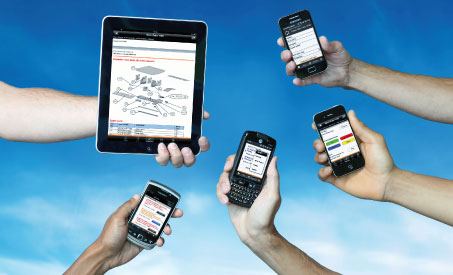
Vanderlande Industries recently introduced its MMS, a unique Mobile Maintenance Solution designed in partnership with mobile automation specialist SCHAD.
Be it the empowering of the passenger through self-service bag drops, the optimisation of centralised baggage management systems, or the facilities enabling travellers to tag their bags from home, rapid developments in airport baggage operations has everyone in the industry wondering what is coming next.
Home-printed bag tags at Billund Airport
A groundbreaking solution at Denmark’s Billund Airport enables its one million charter passengers to print their own baggage tags at home with their boarding pass, days before they arrive at the airport. Travellers print tags onto a piece of A4 paper, then simply fold and insert them into a reusable plastic wallet, provided free of charge in the terminal. The bag can then be deposited at a dedicated Express Drop desk, where it is processed by Unisys technology.
According to the airport’s Marketing Manager Jesper Klausholm, Billund was the first airport in the world to implement the system, which, since its launch in September last year, has been utilised by almost 40% of the airport’s charter traffic. Klausholm said: “People appreciate being able to tag their bags from their own living room. It’s a load off their mind and they feel a lot more prepared for their flight.”
The airport is now developing a system that will allow passengers to select their aircraft seats and pay for overweight baggage from home.
Centralised processes at Brock Solutions
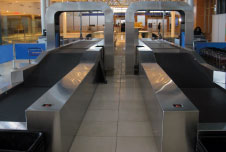
Brock Solutions’ SmartDrop Baggage Image and Weight Identification System (BIWIS) at Edmonton International Airport simplifies the check-in and customs process by automatically capturing the tag number, weight, and photograph of inducted bags.
Brock Solutions pioneered the bag drop process in 2005 at Montreal airport, with its agent-assisted fixed bag drop application, which now operates at airports across the US, Europe and Asia.
Today, at the core of Brock Solutions’ ever-evolving management applications is its SmartSuite database, which intuitively collates baggage-tracking information for centralised baggage handling processes airport or airline-wide.
The suite’s state-of-the-art SmartDrop function puts passengers in charge of their own airport journey with its automatic bag drop solutions. Brock’s latest innovation is the SmartDrop Baggage Image and Weight Identification System (BIWIS), which simplifies the check-in and borders procedure by eliminating the need for passengers to claim and recheck their baggage.
Brock’s SmartSuite applications enhance the airport experience with features such as automated baggage recovery, checkpoint tools that predict queue blockages and real-time baggage status and delay information.
Varilabel’s foolproof self-adhesive bag tags
Last year, 3.5 million travellers used Varilabel’s intuitive bag tags in combination with an autonomous bag drop, and its simple-to-use, people-friendly initiatives have put bag drop into the hands of the passenger at airports across Europe for the last four years.
The true ingenuity of Varilabel’s luggage tags lies in the special adhesive coating that sticks to nothing but itself, meaning that there is only one way for the label to be applied – and it cannot be done incorrectly. The unique adhesive also requires no backing paper and therefore creates no waste, and the process takes just seconds, minimising queues and considerably increasing an airport’s bag drop capacity.
At present Varilabel is developing a system to print its bag tags from a CUSS kiosk in accordance with IATA’s Simplifying the Business initiative.
Safety and simplicity at the centre of ICM Airport Technics
ICM Airport Technics’ Auto Bag Drop unit is optimised for an easy and safe user experience, designed with an unintimidating aesthetic and an intuitive graphical user interface, its innovative side-loading system is easier than front loading and provides a clear area of safety for passengers, while anti-intrusion systems prevent any kind of trapping or injury.
The Auto Bag Drop automatically checks baggage weight and size allowances, prints a heavy bag tag if necessary, checks for non-conveyable and multiple bags, and securely inducts the bag into the baggage handling system, all in under 30 seconds.
Most recently, Heathrow airport has implemented ICM’s latest Auto Bag Drop Series 7, which includes 3D scanning technology to determine whether a bag can be conveyed. In 2013 ICM aims to further enhance its biometric integration and launch its hybrid solution for agent assisted self-service bag drop solutions.
Happy passengers and lower operational costs at Type22
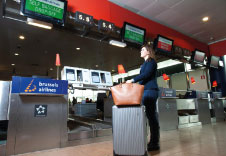
Type22’s Scan&Fly retrofit Self Bag Drop solution was recently awarded the international red dot design award for its high design quality and useability.
Type22 delivers baggage-processing solutions that make hassle-free handling become the standard. Designed to provide the best service to passengers, its latest innovation is the retrofit Scan&Fly Self Bag Drop solution, which brings airports and airlines what today’s passengers want: speed, ease of use, no queues and control over one’s own journey.
Bart Houlleberghs, Commercial Director, said: “We succeeded in creating a compact product, packed with technology for a unique passenger experience, that fits right onto existing check-in counters. No costly changes to the infrastructure or equipment of an airport are required.” Baggage can be dropped in less than 15 seconds, reducing space and capacity constraints in airport terminals and cutting operational costs at check-in in half.
With Scan&Fly installed at Brussels and Rotterdam The Hague airports, Type22 is continuously looking for ways to further improve the Self Bag Drop process. Working closely with airports and airlines to optimise the passenger flow, the Dutch high-tech company is now concentrating on upgrading the self-tagging procedure, developments in Near Field Communication and exploring the potential benefits of home tagging.
DSG Systems’ seven-second bag drop
DSG Systems’ two-step self-service BagDrop solution allows passengers to drop their bags in just seven seconds, and, by the end of 2013, will have been adopted by every capital airport in Europe’s Nordic region. The CUSS facility is designed to improve passengers’ ability to self-check-in with its ‘natural-feeling process’, resulting in less queuing and higher throughput in bottleneck areas. The Norway-based company is also deploying its progressive BRAINS Sort Allocation Computer, with a live stream of data to for monitoring an airport’s baggage system.
DSG Systems is currently pursuing developments for usage of RFID, NFC and other applicable technologies for baggage tagging. Idar Sørgjerd, Managing Director, said: “We strongly believe in removal of the old tag printers and tagging procedures as we see them today, and aim to find solutions which are both effective and competitive for the passenger, airlines and the airports.”
Remote and self-service with BagDrop systems BV
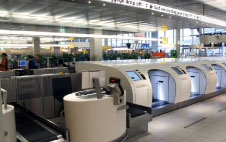
Edwin Sneekes, Director, BagDrop systems: “Remote baggage drop clearly offers airports the opportunity to increase the capacity of the airport without having to expand the physical airport building. From the airline’s point of view it is interesting as the passengers are already identified very early in the process before even arriving at the departure hall.”
BagDrop systems BV’s goal is to deliver increased terminal capacity, an enhanced passenger experience, improved passenger revenue and reduced operational cost by developing remote and self-service bag drop facilities that require minimum passenger input for the most secure baggage process. Around 2.5 million passengers a year use BagDrop’s fully CUPPS compliant facilities, which support 15 different languages, as well as RFID-bag tagging, home-printed bag tags and liner-less label printing.
BagDrop’s facilities have been implemented at Amsterdam Schiphol Airport, Zurich Airport and in Japan at Nagoya airport and are able to process about 30 different airlines with different DCS-systems, as well as giving passengers control of their own bag drop experience.
In 2013 BagDrop will implement functionalities such as common use payment for excess baggage and alternatively functioning bag drop off units.
Complete baggage control at Materna
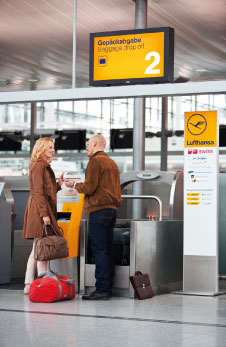
Materna recently installed 39 new Self Bag Drop points for Lufthansa at Munich, Frankfurt and Hamburg airports, which take full control of the bag drop process, and complete it in less than 50 seconds.
The flexibility and modular design of Materna’s baggage handling and check-in application makes it effectively customisable to the particular needs of an airline for a one or two step solution, or even a combination check-in and bag drop facility.
Recently, Materna installed 39 new Self Bag Drop points for Lufthansa, which take full control of the bag drop process, including conveyor management, bar code reading, weight and baggage dimension detection, as well as RFID functionality.
After just three months in operation, the average processing time of the new systems – from identification to tagging and baggage verification – was reduced to less than 50 seconds, 20% below the customer requirement. The facility is capable of handling multiple bags and passenger groups and features the option of switching between languages as the passenger requires.
The German company’s next step is to develop its mobile check-in app and optimise its common use bag drop application for multiple airline environments.
Vanderlande’s new Mobile Maintenance Solution
Vanderlande Industries recently introduced its MMS, a unique Mobile Maintenance Solution designed in partnership with mobile automation specialist SCHAD. MMS integrates supervisory control and data acquisition (SCADA) with enterprise asset management solutions such as IBM Maximo.
Vanderlande will use the application MMS to improve the operational performance of their site-based teams to increase the value and quality of service to their customers. Its customers will benefit because of the higher efficiency, lower costs and improved management reporting of the site-based teams, which will have the ability to monitor system performance from any location using any mobile device over WiFi or GPRS. What makes this solution unique is that it additionally offers maintenance engineers full mobile working capabilities by giving users a seamless integration between their existing SCADA system and IBM’s Maximo maintenance (enterprise asset management) system. This further demonstrates Vanderlande’s commitment to innovations that bring customers’ system availability up and their costs down.
The solution is available now to new and existing Vanderlande customers who have implemented a full service solution and use a permanently site-based Vanderlande support team. Currently, the company has more than 80 site-based teams. The Vanderlande team at London Heathrow Terminal 5 is the first team to use this new mobile solution. The aim is to deploy it at a number of other sites in 2013.
“Vanderlande Industries is the first automation specialist that currently has a mobility offering like this, and we are delighted to be offering integrated mobile SCADA and maintenance as an enhancement to our full service solutions,” said Tjarko Bouman, Director Customer Services. “Mobility clearly differentiates us as a supplier and adds a lot of extra value to the overall benefits of using automation.”
What next for airport baggage processing?
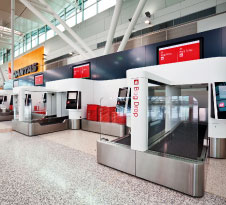
Heathrow airport recently implemented ICM’s latest Auto Bag Drop Series 7, which includes sophisticated 3D scanning technology to determine whether a bag can be conveyed.
“The baggage process will be ever more adapted to the passengers’ individual journey,” said Bart Houlleberghs, Type22. He explained that the integration of personal mobile technology will have the most influence on the baggage processing experience of the future, allowing airports and airlines to filter individualised information to passengers in the right time and place.
Varilabel’s Director Borry Vrieling agrees that passenger autonomy will be at the centre of baggage’s future, and suggests an air travel standard in which passengers will home-print bag tags on their journey out and self-print them at a kiosk on the way home, while frequent fliers will use permanent tags with RFID technology.
Billund’s Jepser Klausholm attested that automated self-service bag drop will become the ‘new normal’, much as online check-in and mobile boarding have become customary in recent years, and Cliff Burchfield, Brock Solutions’ Head Business Development Software Solutions concurred, and also commented that since passengers expect the simplified, ‘Applefication’ of airport processes, baggage information in the future will be even more relevant, simple and easy to access, which is why Brock is in the process of developing its browser and tablet-based solutions. Idar Sørgjerd of DSG Systems furthered this, suggesting that escalating airport technologies such in-terminal WiFi will enable remote, mobile control of different handling systems, streamlining baggage processes for airport and passenger.







